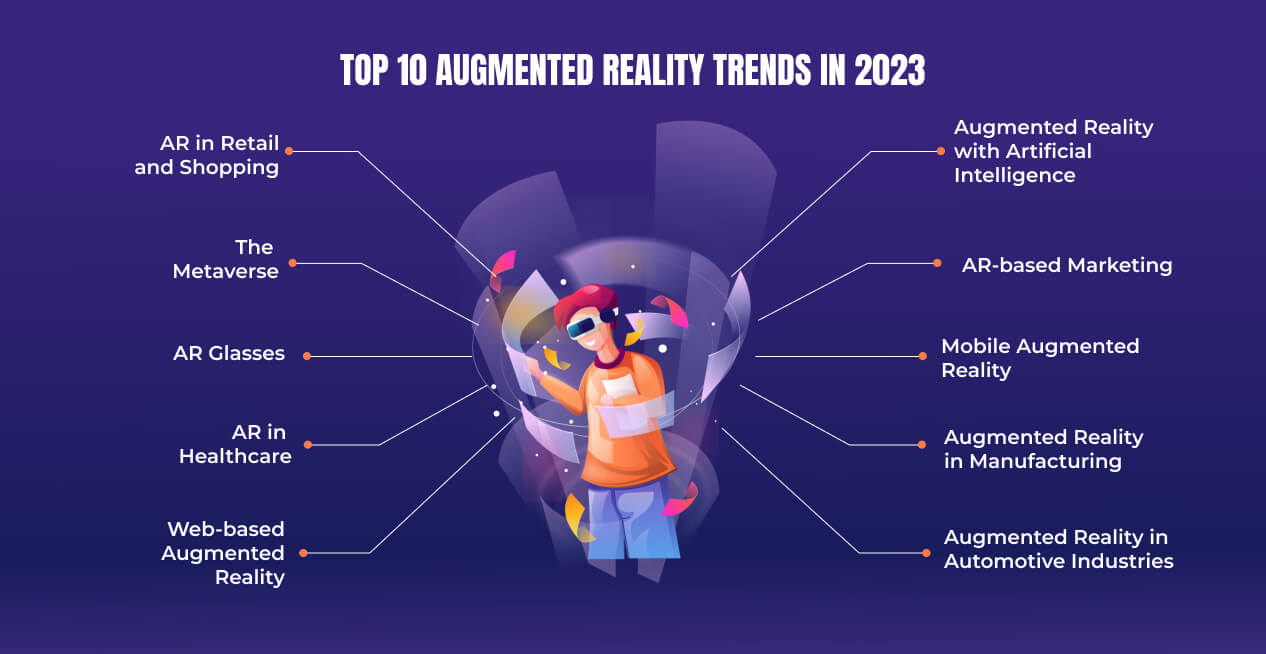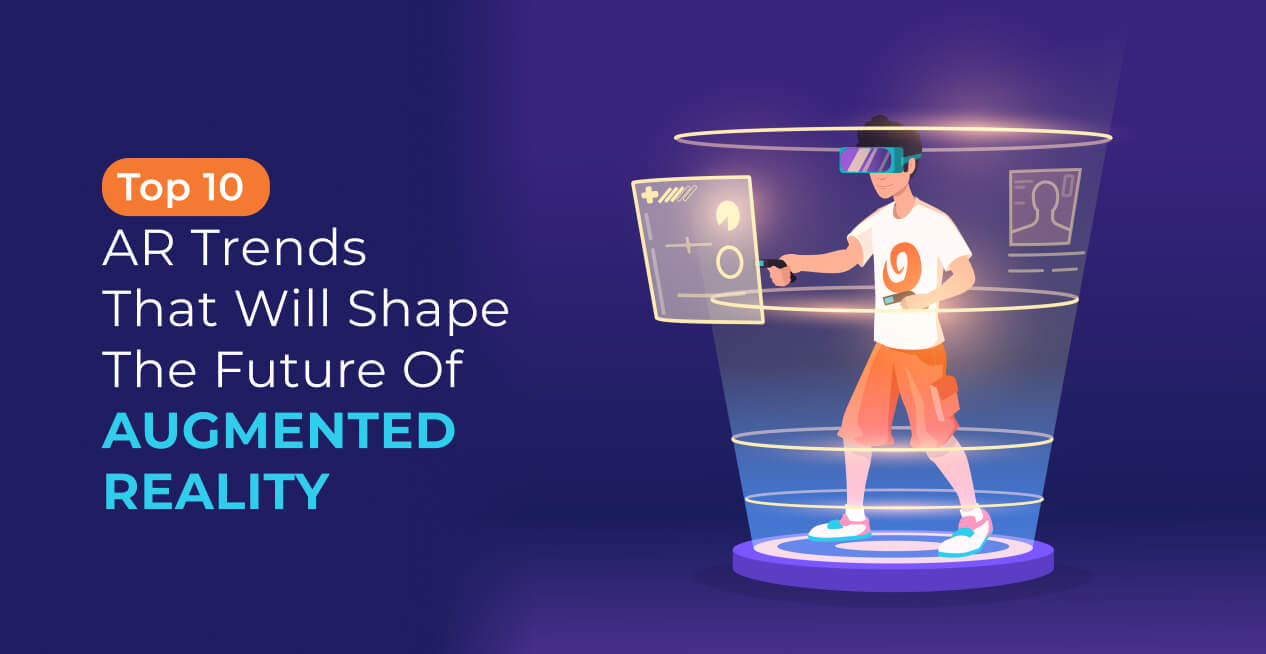-
Trend:1 AR in Retail and Shopping
-
Trend: 2 The Metaverse
-
Trend: 3 AR Glasses
-
Trends 4: AR in Healthcare
-
Trends: 5 Web-based Augmented Reality
-
Trend: 6 Augmented Reality with Artificial Intelligence
-
Trend: 7 AR-based Marketing
-
Trend: 8 Mobile Augmented Reality
-
Trend: 9 Augmented Reality in Manufacturing
-
Trend: 10 Augmented Reality in Automotive Industries
-
The Future of Augmented Reality
In the last couple of years, Augmented Reality has grown rapidly. Augmented reality is gradually intruding into our imagination. It may have started out as a way to bring virtual objects into the real world, but it has evolved into a valuable tool for a variety of industries over the past few years. The future of Augmented Reality appears bright, as it has become a common tool in everyday life. Fortune Business Insights predicts the global Augmented Reality market will expand from $6120 million in 2021 to $97.76 billion by 2028. In the upcoming years, we will see more interesting Augmented Reality trends based on these Augmented Reality statistics.
Various industries use Augmented Reality to solve business challenges, including retail, business, gaming, healthcare, and even the military. In order to know where the industry is headed, it’s important to keep up with Augmented Reality technology trends.

Trend:1 AR in Retail and Shopping
All industries were significantly impacted by the Covid-19 outbreak, but it is clear that the impact on industries with direct consumer contact, like retail and shopping, is greater. Today, we know how Augmented Reality works in retail. We can claim that integrating Augmented Reality into eCommerce and retail experiences is a trend that benefits both consumers and businesses.
The drawbacks of internet shopping, such as product returns, are eliminated by AR and virtual try-on technology, which provides customers with close-contact store experiences wherever they are. More than 60% of shoppers prefer to shop by utilizing Augmented Reality, and 46% of shop owners are impressed by the AR/VR solution. There seems to be an increase in this Augmented Reality trend since this technology can enhance customer satisfaction in the virtual world.
Trend: 2 The Metaverse
With AI-powered AR and VR technology, the market is shifting toward the digital virtual world. Metaverse is a virtual world where people can play, work, socialize, shop, etc using their virtual avatars. The Sandbox is an example of a virtual metaverse. In addition to playing, users can buy virtual land, attend live concerts, and watch sports events. It is widely believed that the metaverse will lead to the future of the internet.
The metaverse can be used to develop companies by removing barriers between the virtual and real worlds. Both consumers and companies can benefit from Augmented Reality since it enables virtual items to be integrated into our real world. Based on how strongly these technologies are relied upon in the metaverse, the future of Augmented Reality businesses looks promising. Virtual reality development offers a great opportunity for businesses to satisfy the market’s growing demand.
Trend: 3 AR Glasses
Traditionally, AR headsets have been favored, but AR glasses are becoming increasingly popular. In late 2025, Apple and other tech giants are slated to release glasses that provide a unique AR experience. Increasing demand for wearables has already made AR glasses one of the key trends in Augmented Reality. The AR smart glasses market is expected to reach $6.21 billion by 2026 at a CAGR of 13.37%, according to Technavio. The market is dominated by Alphabet Inc., Google’s parent company, and HTC. Apart from AR glasses, numerous revolutionary devices are expected to be prominent in the coming years. One of the most recent devices being developed by Meta is the Cambria mixed reality headset. Meta Quest 2 is their successful new product that complements this line.
Trends 4: AR in Healthcare
Medical care is constantly evolving to ensure that doctors and other healthcare workers can give their patients the best treatment. Using Augmented Reality in the healthcare industry is one of the current trends in Augmented Reality. According to estimates, this industry will generate $2.4 billion by 2026. This number is not surprising as the medical community is becoming more aware of the advantages of AR and adjusting to the realities of Covid-19. In order to solve concerns like the complexity of remote patient support and the increased pressure on hospitals, Augmented Reality solutions are becoming more and more crucial. This covers both mental health apps and telesurgery solutions that assist people in maintaining psychological balance during these challenging circumstances. The future of Augmented Reality in healthcare will benefit significantly from the education of patients and healthcare professionals, communication, and patient outcomes.
Trends: 5 Web-based Augmented Reality
In today’s technologically advanced world, web-based Augmented Reality is expanding quickly, especially with the introduction of 5G networking services. Given that it has a lot of room to grow and the number of uses for WebAR, it can be regarded as the next big thing for all facets of the global economy.
Marketing is becoming incredibly convenient for both marketers and consumers by shifting their presence into virtual environments and selling strategically with WebAR. To experience Augmented Reality in real-time while utilizing their current surroundings, all users need to do is visit a webpage. Thanks to the incredibly helpful and interesting immersive experiences that WebAR offers to businesses and agencies. We are surrounded by a wealth of WebAR examples today. Events that used to take a lot more time and money to prepare can now be held by businesses using a digital platform. This new technology is set to revolutionize education, medicine, retail, and many more sectors in the near future.
Trend: 6 Augmented Reality with Artificial Intelligence
It is fair to say that AR and AI are two of the most promising technological advancements of the present day. Additionally, they can be used together to create a unique experience for users. With AR, you can construct a 3D representation of the world by using visual information. You can then use that map to track movement within it.
The combination of AR and AI creates opportunities that were previously unimaginable. You can swap faces in real-time from your phone, change your age visually in real-time, or create an effect like Black Mirror’s People Blocker. Automated design is another use case for combining AR and AI. The SketchAR app is an example of how this technology is being used. This app allows users to draw in AR freely. Alternatively, they can have an AI do the drawing for them. Artificial Intelligence is capable of creating structures quickly. Using the real world as a source environment, AI programs can design objects in 3D space. It will be possible for enterprises to implement AI-assisted AR for their operations in the coming years. This will boost productivity, save on training, and improve knowledge sharing and collaboration.
Trend: 7 AR-based Marketing
As the eCommerce and retail industries develop, Augmented Reality has recently gained more and more attention. Customers who are interested in a product may see how it looks, feels, and fits without having to physically touch or try it out in their homes, thanks to Augmented Reality (AR). Instead of merely bombarding prospects with marketing material, AR enables organizations to demonstrate how their products or offerings stand out, improving the connection and interaction that leads to conversions and sales.
There are several uses for Augmented Reality in the marketing sector. Business cards are one common and easy-to-use choice that can be employed with straightforward AR systems. You can stand out from the competition and provide potential clients with a brand-new and exciting method to discover more about your business by introducing interactivity into marketing materials like business cards. Users may access Augmented Reality (AR) experiences from their timelines via Facebook’s new Augmented Reality advertisements, which come in a variety of forms. These capabilities include virtual try-on, putting virtual items in their houses, and others.
Trend: 8 Mobile Augmented Reality
Mobile Augmented Reality is one of the fastest-growing Augmented Reality Trends today. AR on mobile devices takes advantage of widely available hardware, such as smartphones and tablets. Using Augmented Reality, retailers such as IKEA help customers visualize furniture in their homes before purchasing, making the purchase decision easier. Additionally, Mercedes uses an AI chatbot combined with Augmented Reality. The app provides information about a specific part of the car by scanning it with the phone’s camera. This year, mobile AR is still slated for big development. Smartphone use is increasing, and some people even own multiple devices. This market is likely to attract a lot of attention from app developers and publishers. Therefore, the future of Augmented Reality is bright for mobile apps.
Trend: 9 Augmented Reality in Manufacturing
Consumers are the main focus of many AR applications. Nonetheless, there is a lot of potential for AR to be used in sectors like manufacturing. For example, AR-based training can be improved through the use of CAD data. Additionally, AR can assist personnel with routine maintenance procedures. The use of AR applications can facilitate technicians’ work by highlighting certain components of the item they are working on. Head-mounted systems are generally easier to use than smartphone apps in this regard. In more straightforward applications, AR can assist workers in providing more contextual information about items in a factory. Using a mobile device, a worker can learn more about an object and determine whether maintenance is needed.
Trend: 10 Augmented Reality in Automotive Industries
There are a variety of applications for Augmented Reality in the Automotive Industry. One of the most interesting and futuristic technologies emerging in this space is AR highlights on-road objects through a heads-up display. By using GPS directions and hazard alerts, drivers can stay aware of hazards without taking their eyes off the road. In addition to entertainment and education, AR can also be used in 3D car manuals and other applications.
Empty parking spaces can be highlighted on a driver’s heads-up display with the use of 5G connectivity. The layouts and operations of parking facilities like parking lots and garages can be optimized with the help of the wealth of information that can be obtained from this. Augmented Reality (AR) in the Automotive market size is projected to increase from USD 4.51 billion in 2021 to USD 14.44 billion by 2028.
The Future of Augmented Reality
With the market predicted to reach $97.76 billion in 2028, Augmented Reality is clearly the future for many businesses. Companies that adapt to today’s challenges in new and creative ways will decide that future. It is likely that in five or ten years, if you are out without an Augmented Reality device, you will likely miss out on a lot of the action, from imaginative street art on the walls to flying fantasy creatures, and immersive & individualized advertising. All things considered, we can anticipate that Augmented Reality will merge with everyday life.
Enterprises that provide their clients with excellent AR experiences will be considerably better able to compete with their rivals. If you want to create customized AR experiences for your customers, you can hire Augmented Reality developers at OpenXcell that provide customized solutions for your company.








